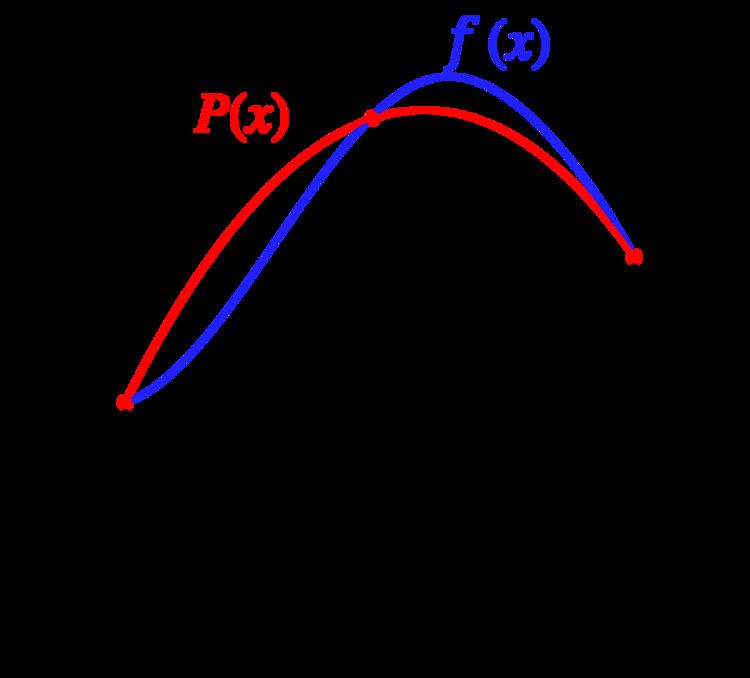 | ||
In numerical analysis, Simpson's rule is a method for numerical integration, the numerical approximation of definite integrals. Specifically, it is the following approximation:
Contents
- Derivation
- Quadratic interpolation
- Averaging the midpoint and the trapezoidal rules
- Undetermined coefficients
- Error
- Composite Simpsons rule
- Alternative extended Simpsons rule
- Simpsons 38 rule
- Simpsons 38 rule for n intervals
- Sample implementation
- References
for points that are equally spaced. For unequally spaced points, please see Cartwright.
Simpson's rule also corresponds to the three-point Newton-Cotes quadrature rule.
The method is credited to the mathematician Thomas Simpson (1710–1761) of Leicestershire, England. Kepler used similar formulas over 100 years prior. For this reason the method is sometimes called Kepler's rule, or Keplersche Fassregel in German.
Derivation
Simpson's rule can be derived in various ways.
Quadratic interpolation
One derivation replaces the integrand
An easy (albeit tedious) integration by substitution shows that
This calculation can be carried out more easily if one first observes that (by scaling) there is no loss of generality in assuming that
Averaging the midpoint and the trapezoidal rules
Another derivation constructs Simpson's rule from two simpler approximations: the midpoint rule
and the trapezoidal rule
The errors in these approximations are
respectively, where
This weighted average is exactly Simpson's rule.
Using another approximation (for example, the trapezoidal rule with twice as many points), it is possible to take a suitable weighted average and eliminate another error term. This is Romberg's method.
Undetermined coefficients
The third derivation starts from the ansatz
The coefficients α, β and γ can be fixed by requiring that this approximation be exact for all quadratic polynomials. This yields Simpson's rule.
Error
The error in approximating an integral by Simpson's rule is
where
The error is asymptotically proportional to
Since the error term is proportional to the fourth derivative of f at
Composite Simpson's rule
If the interval of integration
However, it is often the case that the function we are trying to integrate is not smooth over the interval. Typically, this means that either the function is highly oscillatory, or it lacks derivatives at certain points. In these cases, Simpson's rule may give very poor results. One common way of handling this problem is by breaking up the interval
Suppose that the interval
where
The error committed by the composite Simpson's rule is bounded (in absolute value) by
where
This formulation splits the interval
Alternative extended Simpson's rule
This is another formulation of a composite Simpson's rule: instead of applying Simpson's rule to disjoint segments of the integral to be approximated, Simpson's rule is applied to overlapping segments, yielding:
The formula above is obtained by combining the original composite Simpson's rule with the one consisting in using Simpson's 3/8 rule in the extreme subintervals and the standard 3-point rule in the remaining subintervals. The result is then obtained by taking the mean of the two formulas.
Simpson's 3/8 rule
Simpson's 3/8 rule is another method for numerical integration proposed by Thomas Simpson. It is based upon a cubic interpolation rather than a quadratic interpolation. Simpson's 3/8 rule is as follows:
where b - a = 3h. The error of this method is:
where
A further generalization of this concept for interpolation with arbitrary degree polynomials are the Newton–Cotes formulas.
Simpson's 3/8 rule (for n intervals)
Defining,
we have
Note, we can only use this if
A simplified version of Simpson's rules is used in naval architecture. The 3/8th rule is also called Simpson's Second Rule.
Sample implementation
An implementation of the composite Simpson's rule in Python:
Note that this function is available in SciPy as scipy.integrate.simps.
